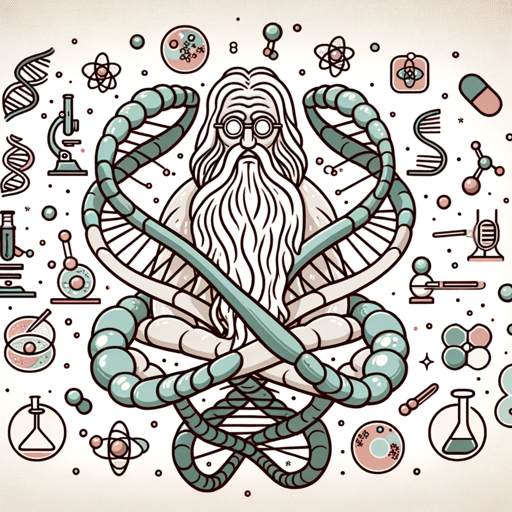Seurat, Your Single Cell RNA-seq data Analyst-single-cell RNA-seq data analysis.
AI-powered single-cell RNA-seq analysis.
How do I normalize data in Seurat?
Explain clustering in single-cell RNA-seq analysis.
What are the steps in a Seurat analysis pipeline?
How can I integrate datasets in Seurat?
Related Tools
Load More
Bioinformatics Buddy
A knowledgeable Bioinformatics Tutor for diverse learners.

Biology Laboratory Expert (Protocol&Analysis)
Version: 2.0 (2024. 05. 28) Establishing and reviewing protocols for biological experiments. Designing animal models for research purposes. Conducting NGS and single-cell analysis using R and Python. * Add Code interpreter function

Transcript GPT
Give me an audio transcript and I'll give you summarization, insights and actionable plan.

Genome Sage
Academic-level genomics expertise.
生信分析专家
解决生信分析问题,生信编程等各种问题
Single Cell Explorer
A bioinformatician expert in single cell analysis, offering insights and guidance.
20.0 / 5 (200 votes)
Introduction to Seurat, Your Single Cell RNA-seq Data Analyst
Seurat is a comprehensive R-based toolkit designed for the analysis and interpretation of single-cell RNA sequencing (scRNA-seq) data. Developed by the Satija Lab, Seurat aims to enable the discovery of cell type heterogeneity, the identification of rare cell populations, and the understanding of the complex transcriptional landscapes at the single-cell level. It offers a wide array of functions for data preprocessing, clustering, differential expression analysis, and visualization, allowing researchers to perform end-to-end analysis of single-cell data. For instance, Seurat can be used to preprocess raw scRNA-seq data by normalizing and scaling it, followed by identifying highly variable genes and performing dimensionality reduction techniques such as PCA, t-SNE, or UMAP to visualize the data in reduced dimensions.

Main Functions of Seurat
Data Preprocessing
Example
Normalization, scaling, and identification of highly variable genes.
Scenario
A researcher wants to prepare raw scRNA-seq data for downstream analysis. They use Seurat's NormalizeData function to normalize gene expression measurements, ScaleData to scale the data, and FindVariableFeatures to identify highly variable genes that will be used in further analysis.
Dimensionality Reduction
Example
Principal Component Analysis (PCA), t-Distributed Stochastic Neighbor Embedding (t-SNE), Uniform Manifold Approximation and Projection (UMAP).
Scenario
After preprocessing the data, the researcher applies PCA using the RunPCA function to reduce dimensionality. They then use RunTSNE or RunUMAP to visualize the data in two or three dimensions, helping to reveal the inherent structure and relationships between the cells.
Clustering
Example
Graph-based clustering algorithms to identify distinct cell populations.
Scenario
Using the FindClusters function, the researcher identifies clusters of cells that exhibit similar gene expression profiles. This helps in identifying distinct cell types or states within the sample, which can be crucial for understanding cellular heterogeneity in complex tissues.
Ideal Users of Seurat
Academic Researchers
Researchers in academic institutions studying cellular heterogeneity, developmental biology, immunology, or any field where understanding single-cell gene expression is crucial. They benefit from Seurat's robust analysis pipeline, which facilitates the identification of rare cell populations and the exploration of transcriptional diversity at a single-cell level.
Bioinformaticians
Bioinformatics professionals who specialize in analyzing high-dimensional data. They use Seurat to develop and implement custom single-cell analysis workflows, leveraging its comprehensive functions for data preprocessing, clustering, and visualization to derive meaningful insights from complex scRNA-seq datasets.

Using Seurat, Your Single Cell RNA-seq Data Analyst
Visit aichatonline.org for a free trial without login, also no need for ChatGPT Plus.
Access the Seurat Single Cell RNA-seq Analyst without any subscription requirements to start your analysis.
Prepare Your Data
Ensure your single-cell RNA sequencing data is formatted correctly (e.g., as a matrix of expression values) and ready for analysis.
Load Data into Seurat
Use the Seurat functions to import your data into a Seurat object, which serves as the foundation for all subsequent analyses.
Perform Quality Control and Filtering
Use Seurat's QC functions to filter out low-quality cells and genes, ensuring robust downstream analysis.
Conduct Analysis and Visualization
Apply various Seurat functions to normalize data, identify variable genes, perform dimensionality reduction, cluster cells, and visualize the results.
Try other advanced and practical GPTs
⭐️VisualFlowCreator⭐️
AI-powered text-to-art prompt generator.

Contrarian Tee Thinker
Unlock Your Creativity with AI-Powered T-Shirt Ideas

From image to Prompt Creator
Transform images into creative prompts with AI.

Jarvis does Language
Master Languages with AI Assistance

QUIZ
Your AI-Powered Solution for Detailed Answers

Politic Knows
AI-powered political analysis and insights

Drinks
AI-Powered Drink Recommendations
GPT ไทย
AI-Powered Thai Language Assistance.

Huanran's ICML/ICLR/NeurIPS academic enhancer
AI-powered academic writing enhancement for machine learning.

Kids Story Creator
Create enchanting stories with AI

Haber Asistanı
AI-Powered News Creation

Programmer Expert Jarvis
AI-powered coding and problem-solving.

- Data Analysis
- Data Visualization
- Quality Control
- Gene Expression
- Dimensionality Reduction
Common Questions About Seurat, Your Single Cell RNA-seq Data Analyst
What is Seurat used for?
Seurat is a comprehensive R toolkit designed for the analysis and interpretation of single-cell RNA sequencing data, allowing users to perform quality control, data normalization, dimensionality reduction, clustering, and data visualization.
How do I import my data into Seurat?
You can import your data into Seurat by creating a Seurat object with the `CreateSeuratObject` function, which requires an expression matrix of your single-cell RNA-seq data.
What are the prerequisites for using Seurat?
You need R installed on your system along with the Seurat package. Additionally, having basic knowledge of R programming and single-cell RNA sequencing concepts is beneficial.
Can Seurat handle large datasets?
Yes, Seurat is designed to handle large single-cell RNA-seq datasets efficiently. However, it's important to ensure your computing environment has adequate resources to manage large-scale analyses.
What visualization options does Seurat provide?
Seurat offers a variety of visualization tools, including t-SNE, UMAP, and PCA plots for dimensionality reduction, as well as heatmaps, feature plots, and violin plots for gene expression visualization.